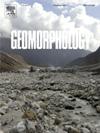Estimating slip distribution along the southernmost ∼80 km of the San Andreas Fault by examining tectonically offset features
IF 3.1
2区 地球科学
Q2 GEOGRAPHY, PHYSICAL
引用次数: 0
Abstract
We measured tectonically offset geomorphic features along approximately 80 km of the southernmost San Andreas Fault (sSAF) between Bombay Beach and Indio Hills in the Salton Trough to obtain a better estimate for slip distribution and slip-per-event for the past several large, surface rupturing earthquakes along this segment of the fault. In addition to gathering aerial imagery from previously published B4 light detection and ranging (LiDAR) and uncrewed aerial vehicle (UAV) imagery, we constructed new high-resolution orthomosaic images and digital surface models (DSMs) generated from Structure-from-Motion-Multiview Stereo (SfM-MVS) techniques from UAV imagery at multiple localities along the San Andreas fault in the Salton Trough region of California, which include study areas at Durmid Hill, Salt Creek, Ferrum, Mecca Hills, and Indio Hills. The aerial imagery, along with field mapping, were used to identify and measure a total of 146 offset features with lateral displacement measurements ranging between 1.5 and 23 m, with all measurements below 2.5 m found along multi-stranded sections of fault. Investigation of offset features suggests that the last several large, surface rupturing events produced average displacements of 3.0–4.4 m per event, with lower overall lateral slip values where multiple fault strands are present. Offset features along sections of the fault with multiple active strands with only partial displacement measured were not considered in our final slip distribution.
通过检查构造偏移特征,估计沿着圣安德烈亚斯断层最南端~ 80公里的滑动分布
我们测量了位于索尔顿海槽孟买海滩和印第奥山之间的最南端圣安德烈亚斯断层(sSAF)约80公里处的构造偏移地貌特征,以更好地估计断层这一段过去几次大的地表破裂地震的滑动分布和每次滑动。除了从先前发布的B4光探测和测距(LiDAR)和无人机(UAV)图像中收集航空图像外,我们还从无人机图像中构建了新的高分辨率正射孔图像和数字表面模型(DSMs),这些图像是由运动多视图立体结构(SfM-MVS)技术生成的,这些图像来自加利福尼亚索尔顿海槽地区圣安地列斯断层沿线的多个地点,包括Durmid Hill, Salt Creek, Ferrum, Mecca Hills,和印第欧山。利用航空图像和现场测绘,共识别和测量了146个偏移特征,横向位移测量范围在1.5到23米之间,所有测量结果都在2.5米以下,这些测量结果都是沿着多股断层段发现的。对偏移特征的研究表明,最近几次大型地表破裂事件每次平均产生3.0-4.4米的位移,在存在多个断层链的地方,总体横向滑动值较低。在我们最终的滑动分布中,没有考虑到带有多个活动链的断层剖面的偏移特征,这些断层只测量了部分位移。
本文章由计算机程序翻译,如有差异,请以英文原文为准。
求助全文
约1分钟内获得全文
求助全文
来源期刊

Geomorphology
地学-地球科学综合
CiteScore
8.00
自引率
10.30%
发文量
309
审稿时长
3.4 months
期刊介绍:
Our journal''s scope includes geomorphic themes of: tectonics and regional structure; glacial processes and landforms; fluvial sequences, Quaternary environmental change and dating; fluvial processes and landforms; mass movement, slopes and periglacial processes; hillslopes and soil erosion; weathering, karst and soils; aeolian processes and landforms, coastal dunes and arid environments; coastal and marine processes, estuaries and lakes; modelling, theoretical and quantitative geomorphology; DEM, GIS and remote sensing methods and applications; hazards, applied and planetary geomorphology; and volcanics.
 求助内容:
求助内容: 应助结果提醒方式:
应助结果提醒方式:


